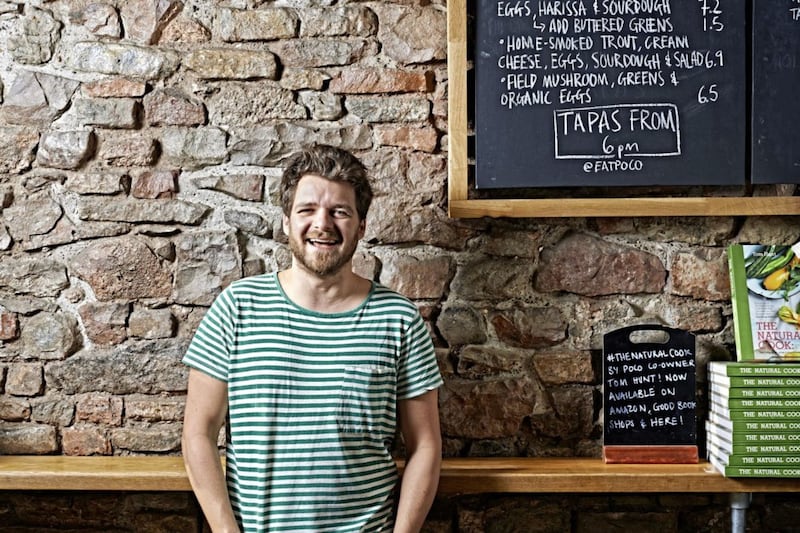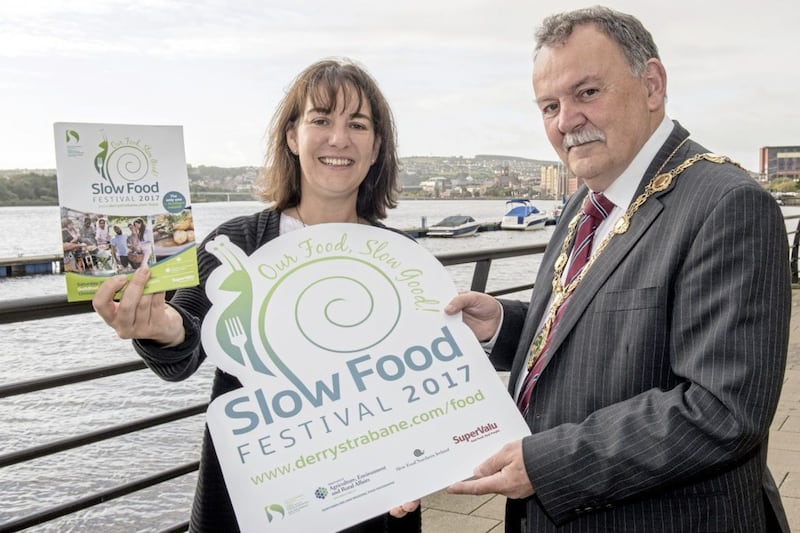THE Slow Food movement, which champions high quality local produce with a commitment to the community and environment, started more than 30 years ago as a stand against fast food. Now, with climate change top of the agenda, it has never been more topical.
Northern Ireland's only Slow Food Festival returns to Derry next month and this year, for the first time celebrated Irish chef Catherine Fulvio will participate for the first time.
Having grown up on a working farm in Co Wicklow, from where she now runs a cookery school, the fundamentals of Slow Food have been at the heart of award-winning cookbook writer Catherine’s family home for as long as she can remember.
“Unbeknownst to my grandmother and mother, we have been supporting Slow Food at our family farm for many generations and in particular since we opened our doors as a Farmhouse Bed & Breakfast back in the 60s,” says Catherine, who is well known to television viewers, having presented cookery shows on both RTÉ and the BBC.
“Today we use a lot of our own fruit, herbs, edible flowers and veg which we grow at Ballyknocken Cookery School and people enjoy picking their own ingredients from the kitchen gardens."
The main principle of the slow food movement is to be sustainable and preserve biodiversity, Catherine says.
"It’s also about the quality of the food we eat – as opposed to convenience – which is music to my ears and means eating fresh, in-season produce locally sourced," she adds.
“I grew up holding on to the strings of my mother’s apron as she cooked three meals per day for the guests in the B&B – she always encouraged me to get involved and I loved it. This experience and helping out on the farm – collecting eggs, gathering potatoes, milking cows and plucking turkeys at Christmas – have all been invaluable and shaped my world, giving me an appreciation for food and the labour of love that is farming and its many rewards.”
The Slow Food movement’s roots are in Italy and Catherine feels she has an ‘Italian heart’ thanks to her Italian connections – her husband Claudio, with whom she has two children, is from Palermo. She believes we can all learn from the Italians' attitude to food.
“What I learnt from the Italians is that they will not compromise on ingredients,” says Catherine. “They eat with the seasons, they enjoy large and leisurely meals with family and they respect food: work, life, family revolve around it rather than the other way around.
“I believe that their Mediterranean diet is the answer to longer-lasting health and happiness. With the Mediterranean food pyramid there is an emphasis on a colourful diet including a wide variety of in-season fruit and vegetables, more beans and legumes, fish and eggs for protein and meat in moderation. Basically it is everything we are being told to do today.
“When cooking dishes there are easy ways of incorporating local produce. For example, in my Italian recipe for Poached Apple Stuffed with Gorgonzola, I substitute with a local cheese such as Sperrin Blue from Tamnagh Foods.”
Catherine insists we can all adapt our eating habits to fall into step with the Slow Food message.
“It’s about eating consciously,” she says. “This means being aware of what we are eating, when we are eating and also slowing down the actual eating process and taking time to eat – you will notice it on your waistline too.
“Also my big thing, simple as it sounds, is to plan and prepare your meals – then you can choose to eat what is in season and locally produced. If you prepare your meals from scratch, then you know exactly what is going in and you will find you have less waste.
“And, last but not least, eat as many vegetables as possible – a colourful plate is a healthy plate.”
Catherine will be putting her advice into action when she cooks at the Slow Food Festival in Guildhall Square next month.
“I will be creating a menu for everyday living,” she says. “I promise to share something that will be doable and delicious without too many ingredients. I believe in keeping things simple and working with the ingredients to hand. Whether I am in Derry or at home in Wicklow, I try to access the best of local produce in season."
Catherine says that what she enjoys most about travelling to food festivals is meeting local people and exchanging food tales with them about what they had in a particular place and why it appealed to them.
"Often it is around Italian food but more and more I hear about Irish produce and get to discover some really wonderful produce that is specific to an area," she says.
"Often when a food producer starts up, their product is only available locally. This is one of the biggest advantages of touring the country – you get to taste it first!
“At Slow Food Festival in Derry I am looking forward to discovering the best-kept secrets from the area and sharing them with everyone. I believe Lough Foyle Flat Irish Oyster will be available so I will be looking out for them…”
:: The Slow Food Festival takes place in Derry from October 9-13. For more details see derrystrabane.com/food. Below are two recipes from A Taste of Home – the Ballyknocken Cookbook by Catherine Fulvio (published by Gill, photography by Harry Weir) for you to try.
BAKED OYSTERS WITH BACON
This is a very traditional recipe, a favourite of my mother’s and found in many older cookbooks.
24 shucked oysters
12 rashers good quality bacon or pancetta, sliced in half
24 cocktail sticks
large knob of butter
4 tbsp breadcrumbs
1 tbsp finely chopped parsley
A generous handful of seaweed to garnish oyster shells
For presentation, a handful of rocket leaves
Method:
Preheat the grill on high. Wrap each oyster in a bacon rasher and secure with a cocktail stick. Place on an oiled baking tray under the grill until the bacon is crispy. Keep an eye on them.
For the topping, heat the butter in a frying pan over a medium heat. Add the breadcrumbs and lightly brown. Remove from the heat and add the chopped parsley. Mix well and set aside.
Bring a saucepan of water to the boil and drop in the seaweed for just a few seconds. As soon as it becomes a brighter green, transfer the seaweed to iced water, then drain. Place in a layer on the serving platter with the oyster shells on top.
Put a few rocket leaves into each oyster shell. Take the cocktail sticks out of the wrapped oysters and arrange the oysters in the shells. To serve, spoon some breadcrumbs over each oyster and serve immediately.
POACHED APPLES STUFFED WITH GORGONZOLA
We automatically think of poached pears with cheese, but apples are a little more unusual and bring a whole new twist to a traditional combination. Keep the leftover poaching liquid for drizzling over desserts and ice cream.
300ml red wine
200ml water
100ml Marsala
50g caster sugar
4 tbsp honey
1 lemon, zest and juice
2 rosemary sprigs
6 Golden Delicious apples, halved and cored garden salad leaves
160g Gorgonzola, crumbled
3 tbsp roughly chopped walnuts
Method:
Combine the red wine, water, Marsala, sugar, honey, lemon zest and juice and rosemary in a saucepan. Bring to the boil and simmer for five minutes. Add the apples and poach for about 15 minutes, then allow to cool in the poaching liquid.
Remove and slice the apples in half. Bring the poaching liquid to a simmer and reduce until it's slightly more syrupy. Place the salad leaves on a platter.
Place the apples on the leaves and sprinkle with Gorgonzola and walnuts. Drizzle over a little of the syrupy poaching liquid.
(Keep it local by using local apples and a cheese produced near you!)






